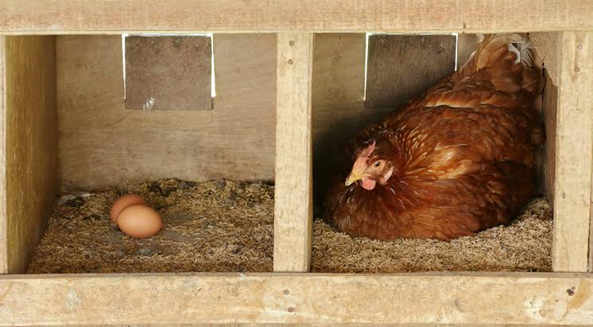FLOCK SPACE REQUIREMENT
Poultry
At 6weeks of age, birds attain 650-750g body weight. These birds can be let out under backyard free-range system@ 10-12 birds/ house depending on the area and natural feed base available. About 200 adult birds can be reared per acre of land (or) 400-500 young birds per acre of land.
Skills to limit the Predators
- The easiest way to prevent predation is to keep flocks within buildings. However, for the majority of backyard flocks and organic flocks, this is unfeasible or is not a desired alternative.
- Lock birds up during the night and maintain a vigilant eye.
- Open poultry houses should be enclosed by fine meshing to prevent entry by wild birds.
- Motion sensor lights and sound equipment can be used.
- Objects with motion, i.e., flags and pinwheels, CD’s on thin wire.
- Loud noises.
- Scare crows and dummy predator birds.
- Chemical/pheromone repellents.
- Diversion feeding.
- Fence wire size – small enough to prevent predators.
- Dig a trench 12 inches to 1.5 feet deep around the entire coop and bury hardware cloth there. This will prevent digging predators.
- Elevate the coop off the ground to help prevent mice, rats and weasels from getting into the coop.
- Inspect the bottom of the coop and patch any holes where predators could gain entry.
- Check around windows and doors – any point of entry for an entry.
- Keep your compost pile far away from the coop and don’t allow food scraps to linger – clean up any food scraps that the chickens don’t eat before nightfall.
- Keep the area around the coop mowed and clear – an open field without cover is a deterrent to predators.
- If you have serious problems with hawks and owls, consider covering the chicken run with hawk netting.
- If in pasture, consider long narrow rotational grazing areas.
- Cover outside runs with mesh wire or netting to prevent problems from flying predators.
- Tall leafy vegetation provides cover for birds to hide.
Night Shelter
A major advantage of the homestead poultry system is the ability of chickens to find their own feed. Providing a coop for night shelter and allowing scavenging during the day is often the best system for rural poultry farming. If possible, fencing in a small area around the coop is useful for supplementary feeding and monitoring chickens. Night shelter should have good ventilation, required light and protection.

When constructing a night coop, the following points must be considered:
Location of the Night Coop
The night coop needs to be in a shady area on flat dry ground if possible. The area around the coop should be cleared of bushes and tall grass to keep snakes and rats away. About 3 meters of cleared area on each side is good. The coop should be near the house to hear the chickens if they are disturbed by predators or theft. Attaching something to the door or fencing that makes a loud noise, like a bell, will alert home owners if someone is trying to take a chicken. The movement of the sun and wind needs to be considered when deciding the position of the coop. This will provide natural shade and ventilation at certain times of the day. The coop should face south or east in humid climates. To provide a source of light and warmth in the winter and good ventilation in the summer, place windows on the south side of the coop. If the coop is rectangular in shape the end walls need to face east and west so only these walls are hit by the hot morning and afternoon sun.
Size of the Night Coop
The size of a night coop will depend on the space and materials available, and the size of the flock. The coop needs to be large enough that the flock is comfortable so they don’t peck each other, and so the space does not become filled with humidity and gasses. A recommended size for a flock of 10-15 chickens is 1 meter x 2 meters. It is best if the night coop has 2 rooms. The larger room is for roosting. The smaller room should be used for nesting, and should have laying boxes and nests. This space could also be used as holding area for mother hens and chicks during the first few weeks after hatching while using the basket system (more details in chick management section).
